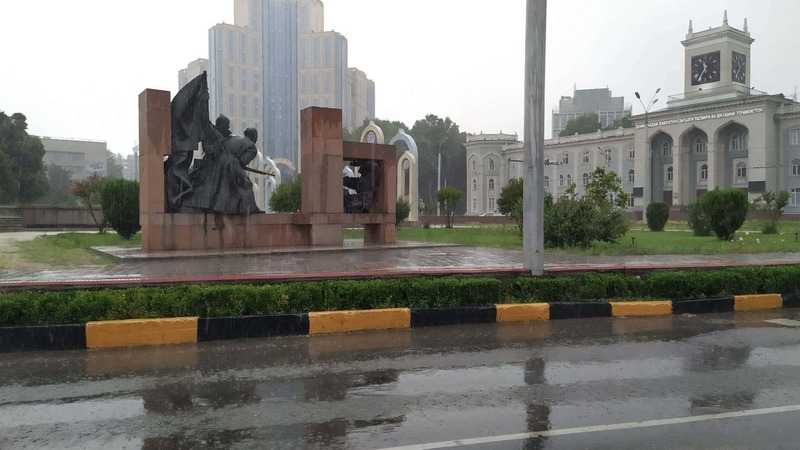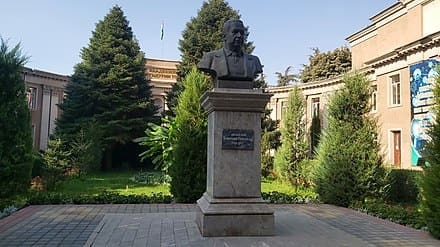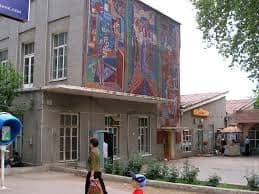Rudaki Avenue, Dushnabe
There's a Rudaki Street, too?!
As if there were not enough buildings, parks, museums and monuments named after this 9th-century poet Rudaki in Tajikistan. We also find the leading thoroughfare running through the capital taking on his name.
Were just lucky that his full name Abu 'Abd Allāh Ja'far ibn Muḥammad al-Rūdhakī wasn't used in the naming process. This would be difficult for any GPS.
Formerly Lenin street, now called Rudaki (Prospekt) Avenue, this road runs north from Dushanbes train station, past many of the city sites and highlights.
For many visitors, a walk down Rudaki Avenue is not only a walk through the capital but a walk back through the history of Dushanbe.
As time goes by, Dushanbe is changing with the demolition of many Soviet-era buildings. The once numerous tree-lined streets are slowly disappearing. Thankfully Rudaki Avenue seems to have avoided many of these ravages.
Rudaki Avenue runs from North to South in a roundabout kind of way, as it cuts through the heart of the city. The street is home to many government buildings responsible for the running of the country; it also has shops, city squares, universities, apartments and restaurants dotted along its path. The Avenue shaded by beautiful trees incorporates a central tree-lined boulevard perfect for cover on those hot summer days.
For our walking tour, we are going to start at the Dushanbe train station, if you wish you can imagine that you have arrived at your destination using the old train from Moscow.
Tomb of Rudaki
Dushanbe Train Station
Looking back at the train station, it's a little unfortunate as it hasn't escaped modernisation.
The Station was once well known for its stained glassed windows and much of its Soviet styling. These features, unfortunately, have now gone in favour of clear glass panels and its discreet beige replaced by blue and white strips. We're pleased as the stylised sign atop the building has remained. The Dushanbe train station was also the site during Tajiks fierce civil war of many thousands of Russians trapped in busses trying to flee the war-torn country.
We follow Rudaki Avenue to the North crossing past Ploshchad Ilyicha roundabout at its centre a medium fountain.
This roundabout is named after the statue located in the boulevard at the start of Rudaki Avenue.
Valerian Kuybyshev Statue
From 1906 to 1914, Kuybyshev carried out various subversive activities across the Russian Empire to aid the Bolsheviks cause.
Once the Bolsheviks came to power, he was to serve as a full member of the Politburo as well as one of the leading economic advisor's to Joseph Stalin. Valerian Kuybyshev was to pass away in 1935 then laid to rest outside the walls of the Kremlin.
As was the norm at the time, cities and towns were named after him and several statues erected in his honour. One of the last figures is found here in Dushanbe standing overlooking the train station.
Walking up the central boulevard sheltered by large trees is quite a pleasant experience.
Either side of the street the once discreet shop fronts have now made way for modern glass windows able to advertise their wears. Many of the buildings do still do retain their neoclassical architectural style from the Soviet period.
Alternatively, some of the more blokey Krushevsky style apartments are hiding away on the side streets.
As one continues with walking a little further to the right, there is the Tajik Gas building.
Tajik Gas Building
Worth a stop to view its Soviet modernist design with a rather decorative grille surround, its style typical of the time. Tajik gas used to be responsible for the transfer of gas from Uzbekistan across the country although as relations soured other energy sources utilised.
Natural gas is now an unpopular choice although with the recent thawing and a blooming friendship in the works with Uzbekistan maybe its fortunes of will reverse.
As we follow the central boulevard, the trees open up to a small square and crossroads. The street crossing Rudaki Avenue here shares the same name as the delightful square.
Both named Ayni after the Tajik hero Sadriddin Ayni.
.jpg)
Ayni Square
Sadriddin Ayni revered throughout Tajikistan was a national hero famous for the cunning yet dangerous game he was to pursue with the Soviet Union.
Responsible for communist uprisings and revolutions in Uzbekistan and Tajikistan while also forming a plan for a recognised Tajik territory.
Not only did he survive several soviet purges but was awarded the order of Lenin three times and even outlived Stalin. Today his statue still stands tall marking this busy intersection, almost ignored by the modern passersby.
The square is home to a rather impressive Soviet-era monument presenting various scenes as diverse as a man breaking the bonds of slavery and a Basmarchi rebel shot by a Soviet soldier.
From the square, Rudaki Avenue heads North West, before moving on pause to admire the surrounding architecture and history.

The Hotel Poytakht (formerly hotel Dushanbe)
Across the street to the left, stands the large concrete façade of The hotel Poytakht, once known as the hotel Dushanbe. The hotel had to change its name when it the use of either Tajikistan or Dushanbe was made illegal for naming businesses cunningly the name Poytakht means capital in Tajik-Persian.
Other then the name change little else has changed here since the Soviet period, the interior is dark, staff are just as grumpy, and the furniture in each room remains the same.
Upon my last visit, even the breakfast tasted like it was cooked in 1975.
Tajik Institute of Art and Design
Turn to the right, and you will notice the pleasant-looking building which is now home to the Tajik Institute of Art and Design. Formerly the building once housed the Behzod museum; its exhibits swallowed up by the cavernous national museum. This beautiful building is a mix of neoclassical design with Islamic style features and arches.
We hope it remains although its design is a little at odds with the new buildings moving in.
Continuing up Rudaki Avenue, there are signs of more modern marble-clad monstrosities permeating through to the old street. For now, though they are easy to ignore as one walks on.
Ignoring the new, focus to the right, and the quaint board of education painted a stylish cream and pink with pleasant balconies pops into view.
This building marks a row of offices similar in design, constructed in the 1960s.
Tajik National State University
Over the road to the left one can not miss the grand building of the Tajik National University, an excellent example of the fusion between central Asian and Soviet architectural design. Above its main entrance, a portrait of Tajikistan's president stands proud.
The building viewed from the road is for administration while the leading educational facilities are behind and dotted across the city. The faculty has been responsible for amongst others the education of Tajikistan's current president.
When passing, there is always a friendly student waiting to shout out hello.
Continuing to make our way towards the heart of Dushanbe, we have the bank of Tajikistan and the Ministry of Justice buildings.
Across the road from these two buildings is a small square with an impressive fountain at its heart.
To the right, we have the hotel Vakhsh.
The Hotel Vakhsh
The three-floored hotel Vakhsh stands proud dominating the corner to the Southeast of the Square. Noticeable by its uncomplicated design and smartly painted pink and white façade to the right of the building is a picture of the president waving out at you.
The Hotel Vakhsh has a mixed history. During the 2nd world war, it served as a hospital treating many sick and injured Soviet soldiers. Unfortunately, those who did not make it are in Victory park located at the fringes of the city.
Much later it was to serve as the party headquarters for the United Tajik opposition which fought against the government in the 90s. If you want a feel of the old, this is the hotel for you. It is un-renovated and in need of a little love but gives that real Soviet-era feel.
Ainy Opera and Ballet Theatre
Beyond the square, the building that dominates one's view due to its size and attractiveness is the Ainy Opera and ballet theatre.
Constructed during the 1950s this opulent construction is as sumptuous on the inside as the outside. If you have time, make sure to return for an evening performance the interior still houses its original plush Russian décor and wide marble staircases.
In the square, outside is still to be found the water fountain from the same period although it has gone through a recent upgrade offering a daily musical light show (we're not sure Stalin would approve). This small square is best visited during national holidays when locals will gather to celebrate.
Keeping with our adventure following Rudaki Avenue further along to the left, we have another educational instate the Academy of sciences.
.jpg)
The Acadamy of Sciences
A bust of Bobojon Gafurov watches over the entrance to the Acadamy. Bonbojon is not just famous for writing a bunch of books and appearing on the 50 Somoni note. Bobojon Gafurov was vital in helping define Tajik national identity.
In his straight-talking manner, he was to explain that Tajikis were not just Uzbeks who had forgotten their language as has been claimed.
He described Tajikis as proud people with their own set of historical characters and events evolving in a country separated from its neighbours by political and geological forces. He has also written some great books on Tajik history notably the History of Tajikistan and The Tajiks (both worth a read for a much more in-depth view of the country).
Amongst Bobojon's many appointments, the most important was Director for the Academy of Sciences (for the whole Soviet Union).
From the Acadamy of sciences building, you may wish to cross and view of the bright yellow ministry of culture we agree not the most impressive building, but pleasant to see and the gardens are always lovely. Just past the ministry of culture, staying on the right is the once Firdausi Library now the Accounts Chamber of Tajikistan.

Accounts Chamber of Tajikistan
This building stands out adorned with the busts of various Tajiki literal giants including Rudaki himself.
Since the opening of the new massive national library, the books once housed here have been relocated, and the building turned over to the Accounts Chamber of Tajikistan.
Former Dushanbe Airport
Cross the road again look back, and as you pass over the crossroads with Bukhoro street, on the wall of a rather uninspiring building, you will notice a very impressive mosaic. The structure here marks all that remains of the original Dushanbe airport. The airport was relocated late in the 1940s a wise decision to allow for the growth of the city.
Continuing on the newer buildings that dominate the skyline on the right were constructed in 2008- 2011. These odd-looking additions do look as though the plans for their construction were upside down as they are wider at the top! Known as Dushanbe plaza they function as rented offices, at the top is a rather poor restaurant but the views from here are very good.
As we near the end of the street to the right, the national information agency stands out with its soviet-style block architecture.
Those Tajiks that have visited inside here, always mention that although the building looks big outside inside is very small.
As Rudaki Avenue opens up at this significant city junction, we are indeed in the heart of the city. To the right stands a rather pretty neo-classical style building. This attractive building is the importantly sounding Parliament of the Republic of Tajikistan.
In reality, the Parliament of the Republic of Tajikistan is only opened for meetings twice a year.

The Statue of Ismail Samani
Across the road, one can not miss the giant statue of Ismail Samani dominating Ozodi square. This 10th-century hero rises 25 metres high and marks the place where Dushanbes resident statue of Lenin once stood.
This impressive monument was constructed in 1999 to mark the 1100 anniversary of the Samanid state.
Abu Ibrahim Isma il ibn Aḥmad was the famed founder of the Samanid dynasty said to have been born in the region. Ismail Samani renounced Zoroastrianism belief and was to embrace Islam.
Since the collapse of the Soviet Union, his image, along with others, has been used to define Tajik national identity. In many of Tajikistan's major towns and cities, the statue of Ismail Samani takes now the pride of place. The nation's currency is also named Samani with this ancient hero claiming the largest denomination.
When at the statue there is police present to stop people from getting to close, this may have something to do with the crown of Ismail Samani.
The crown atop the monument contains 10KG of pure gold, making a precious addition.
Rudaki Park
Following Rudaki Avenue to the North one will pass a lush green park to the right. The aptly named Rudaki Park also contains a statue of this famed Persian Singer, musician and poet. The Park is a scenic, meticulously landscaped garden area featuring fountains, statues, manicured lawns, trees from across the globe and a plethora of stunning flowers.
Depending on your visit, it can be a real assault on the senses.
The centrepiece of Rudaki Park is, of course, a statue of Rudaki. This impressive sculpture has the poet standing under a beautifully decorated mosaicked rainbow.
The figure stands amongst a remarkable fountain of which part doubles as a stage. During national holidays and summer weekends it's excellent to view Tajik singers and the locals dancing along to a few tunes.
As one's legs begin to tire along this historical yet beautiful avenue, the last port of call will be the Presidential Palace.
The Presidential Palace
Located beside Shahidan Square, on the junction with Ismoil Somoni Street this large beige coloured building was formerly the headquarters of the Tajik Communist Party. The buildings typical Russian architecture has the usual central Asian features added for good measure.
Fenced in by high railings the grounds and exterior of the Palace can still be admired do take care; President Emomali Rahmon doesn't reside there any longer, but guards always keep watch over the area.
If making this walk with stops and photos, it will likely take around two hours.
If you choose to include a coffee, cake and some shopping along the route, which we strongly recommend, then it will likely take from 3-4 hours.